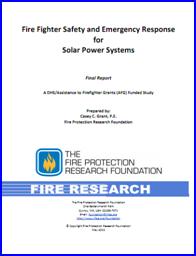Fire Fighter Safety and Emergency Response for Solar Power Systems
 Today's emergency responders face unexpected challenges as new uses of alternative energy increase. These renewable power sources save on the use of conventional fuels such as petroleum and other fossil fuels, but they also introduce unfamiliar hazards that require new fire fighting strategies and procedures.
Today's emergency responders face unexpected challenges as new uses of alternative energy increase. These renewable power sources save on the use of conventional fuels such as petroleum and other fossil fuels, but they also introduce unfamiliar hazards that require new fire fighting strategies and procedures.
The paper attached was prepared by Casey C. Grant, P.E. at the Fire Protection Research Foundation.
Introduction and Background
Amongst the new challenges facing the U.S. fire service is the changing nature of emergency response to incidents where alternative energy sources are in use. The term alternative energy describes any of the various renewable power sources that can be used in place of conventional fuels such as petroleum and other fossil fuels.
The fire service has identified a number of areas of particular concern with respect to hazard mitigation and emergency response in these scenarios. As the use of alternative energy proliferates, it introduces new and unexpected hazards that confront and challenge responders in an emergency.
Some fire service organizations are in the process of developing recommended emergency response procedures and best practices on a local or regional basis; in other jurisdictions, basic
information on the hazard and appropriate response is lacking or not currently available. This project will take a comprehensive national look at the needs of the fire service for credible information and best practices in order to address these topics for first responders and provide an overall coordinated perspective on this topic.
The goal of this report is to assemble and disseminate best practice information for fire fighters
and fireground incident commanders to assist in their decision making process for handling fire
incidents in buildings equipped with solar power systems or in the systems themselves.
Specifically, this study focuses on structural fire fighting in buildings and structures involving
solar power systems utilizing solar panels that generate thermal and/or electrical energy, with a
particular focus on solar photovoltaic panels used for electric power generation.
While this report addresses issues of concern on solar power systems, a separate companion
report addresses electric drive and hybrid electric vehicles, and it specifically addresses those
emergency events involving electric drive and hybrid electric vehicles either near or within structures (e.g. residential garage). The project deliverables will be in the form of a written
report, which will include best practices that can serve as the basis for the development of
training programs by others.
Click here to read the complete report. [Note: it is 99 pages, and 3,061 KB, so depending on your internet speed, it may take some time to download.]